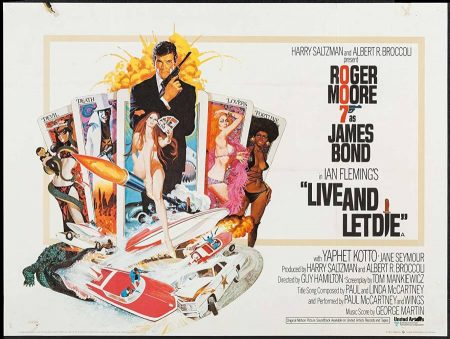Live and Let Die movie synopsis. When James Bond investigates the murders of three fellow agents, he soon finds himself a target, evading the vicious assassins as he closes in on the powerful Kananga. Known as “Mr. Big”, Kananga is coordinating a globally threatening scheme using tons of self-produced heroin. As Bond tries to unravel the mastermind’s plan, he meet Solitaire, the beautiful Tarot card reader whose magical gifts are crucial to the crime lord. Bond, of course, works his own magic on her, and the stage is set for pulse-pounding action sequences involving voodoo, hungry crocodiles and turbo-charged speedboats.
Live and Let Die is a 1973 spy film and the eighth film in the James Bond series produced by Eon Productions and the first to star Roger Moore as the fictional MI6 agent James Bond. It was directed by Guy Hamilton and produced by Albert R. Broccoli and Harry Saltzman. Although the producers had wanted Sean Connery to return after his role in the previous Bond film Diamonds Are Forever, he declined, sparking a search for a new actor to play Bond; Moore was signed for the lead role.
The film is based on Ian Fleming’s 1954 novel of the same name. The storyline involves a Harlem drug lord known as Mr. Big who plans to distribute two tons of heroin for free to put rival drug barons out of business and then become a monopoly supplier. Mr. Big is revealed to be the alter ego of Dr. Kananga, a corrupt Caribbean dictator, who rules San Monique, a fictional island where opium poppies are secretly farmed. Bond is investigating the deaths of three British agents, leading him to Kananga, and he is soon trapped in a world of gangsters and voodoo as he fights to put a stop to the drug baron’s scheme.
Live and Let Die was released during the height of the blaxploitation era, and many blaxploitation archetypes and clichés are depicted in the film, including derogatory racial epithets (“honky”), black gangsters, and pimpmobiles. It departs from the former plots of the James Bond films about megalomaniac super-villains, and instead focuses on drug trafficking, a common theme of blaxploitation films of the period.

It is set in African-American cultural centres such as Harlem and New Orleans, as well as the Caribbean Islands. It was also the first James Bond film featuring an African-American Bond girl romantically involved with 007, Rosie Carver, who was played by Gloria Hendry. The film was a box office success and received generally positive reviews from critics. It was also nominated for the Academy Award for Best Original Song for “Live and Let Die”, written by Paul and Linda McCartney and performed by their band Wings.
Principal photography began in October 1972, in Louisiana. For a while, only the second unit was shooting after Moore was diagnosed with kidney stones. In November production moved to Jamaica, which represented the fictional San Monique. In December, production was divided between interiors in Pinewood Studios and location shooting in Harlem. The producers were reportedly required to pay protection money to a local Harlem gang to ensure the crew’s safety. When the money ran out, they were forced to leave. Some exteriors were in fact shot in Manhattan’s Upper East Side as a result of the difficulties of using real Harlem locations.
Yaphet Kotto later stated “There were so many problems with that script… I was too afraid of coming off like Mantan Moreland… I had to dig deep in my soul and brain and come up with a level of reality that would offset the sea of stereotype crap that Tom Mankiewicz wrote that had nothing to do with the Black experience or culture.” Kotto said he did this by drawing “on a real life situation I was going through and that saved me… but the way Kananga dies was a joke… The entire experience was not as rewarding as I wanted it to be.”
Ross Kananga suggested the stunt of Bond jumping on crocodiles, and was enlisted by the producers to perform it.[1] The scene took five takes to be completed, including one in which the last crocodile snapped at Kananga’s heel, tearing his trousers. The production also had trouble with snakes. The script supervisor was so afraid that she refused to be on set with them, an actor fainted while filming a scene where he is killed by a snake, Jane Seymour became terrified as a reptile got closer, and Geoffrey Holder only agreed to fall into the snake-filled casket because Princess Alexandra was visiting the set.
The boat chase was filmed in Louisiana around the Irish Bayou area, with some interruption caused by flooding. 26 boats were built by the Glastron boat company for the film. 17 were destroyed during rehearsals. The speedboat jump scene over the bayou, filmed with the assistance of a specially-constructed ramp, unintentionally set a Guinness World Record at the time with 110 feet (34 m) cleared.[19] The waves created by the impact caused the following boat to flip over.
The chase involving the double-decker bus was filmed with a former London bus adapted by having a top section removed, and then placed back in situ running on ball bearings to allow it to slide off on impact. The stunts involving the bus were performed by Maurice Patchett, a London Transport bus driving instructor.[1]
Live and Let Die (1973)
Directed by: Guy Hamilton
Starring: Roger Moore, Yaphet Kotto, Jane Seymour, Clifton James, Julius Harris, Geoffrey Holder, David Hedison, Gloria Hendry, Bernard Lee, Lois Maxwell, Tommy Lane, Earl Jolly Brown
Screenplay by: Tom Mankiewicz
Production Design by: Syd Cain
Cinematography by: Ted Moore
Film Editing by: Bert Bates, Raymond Poulton, John Shirley
Costume Design by: Julie Harris
Set Decoration by: Simon Wakefield, Frederic C. Weiler
Art Direction by: Syd Cain, Robert W. Laing, Peter Lamont
Music by: George Martin
MPAA Rating: None.
Distributed by: United Artists
Release Date: June 27, 1973 (United States)
Views: 397



